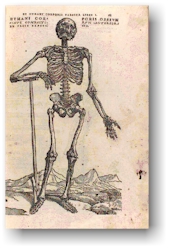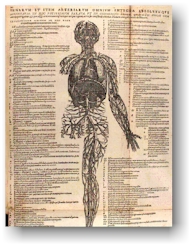

|
Although there are billions of people in the world, every one is an unique individual who differs from any other in various aspects (e.g., size and skin color). On the other hand, each single body contains the same kind of cells and is made up of similar structures. |
雖然地球上的人口是數以億計,但每一個人均是一個獨一無二的個體,在各方面(如身型、膚色等)都經常存在著一定程度的差異。另一方面,每個人的身體卻是包含著相同種類的細胞,並且是由相類似的結構所組成。 |
|
|
|
千百年以來,人類都在嘗試找出人體運作的原理。古代的中國人和埃及人,可能是最早對人體進行深入研究的文明部俗。不過,一般都認為希臘的醫師希波克拉底 (Hippocrates,公元前 460 至 377 年)才是率先採用科學的態度去從事人體研究的先驅。因此,他也常被喻為“現代醫學之父”。 |
|
|
|
然而,最先為人體結構作出了精確敘述的人,要算是比利時的解剖學家 Andreas Vesalius(1514 至 1564)。Vesalius 在 24 歲的時候就已成為義大利帕多瓦大學的解剖學教授。在其著作《人體構造論, On the Fabric of the Human Body 》中,就有很多詳細地描繪了人體不同部位的插圖,Vesalius 並首次展示了這些部位是如何互相結合在一起的情況。由於在十五世紀時還未有顯微鏡,Vesalius 只能描述憑肉眼所能觀察到的景物。 |



|
With the invention of the light microscope in the 17th century and electron microscope in the 20th century, scientists become able to conduct more in-depth studies of the human body. Electron micrographs today can even show how cells interact with each other, and change pathologically during diseases. |
自從光學顯微鏡和電子顯微鏡相繼於十七世紀和二十世紀出現以後,科學家已能對人體作更深入的研究。電子顯微照片甚至能夠展示細胞是如何互相影響和它們在患病時是如何變異的情況。 |


|
人體結構的層次 |